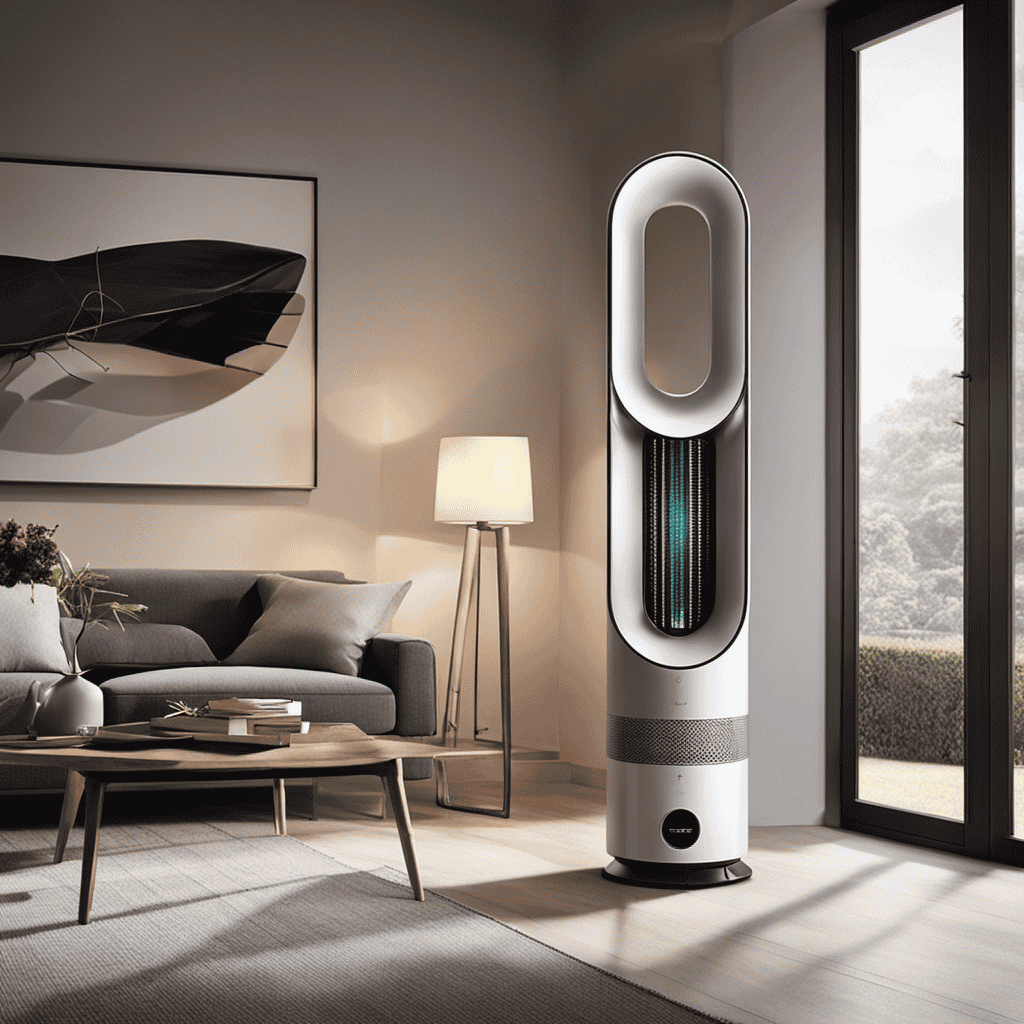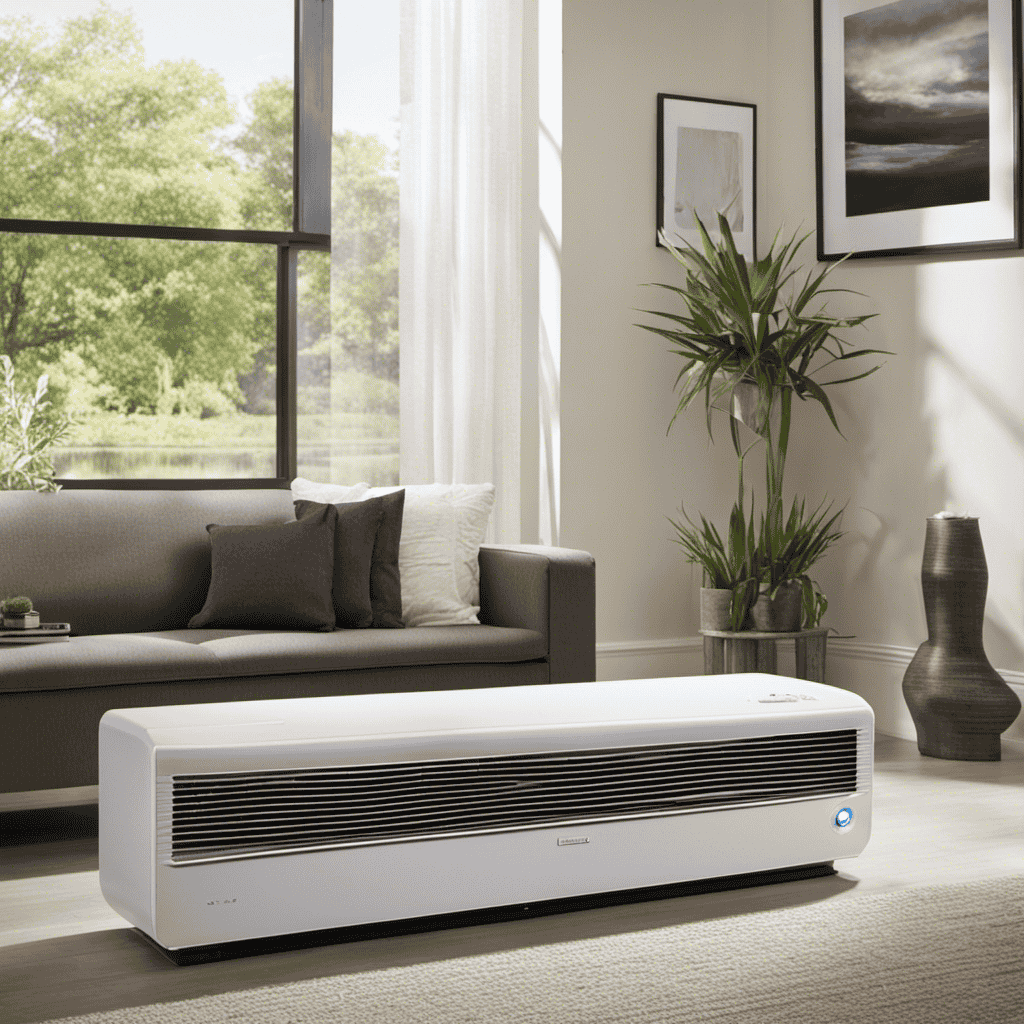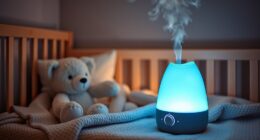I have to confess, I didn’t used to pay much attention to the filter in my air purifier. It was simply another part, quietly working in the background.
But then I started to wonder, how often should I actually be changing that filter? Is it something I need to keep a closer eye on?
In this article, we’ll delve into the factors that affect filter lifespan, the recommended frequency for filter changes, and signs that indicate it’s time for a replacement.
So, let’s uncover the secrets behind maintaining clean and healthy air in our homes.
Key Takeaways
- Efficiency rating of the filter and air quality in the area are important factors affecting the lifespan of an air purifier filter.
- Regular maintenance, such as cleaning or replacing the pre-filter, can extend the filter’s lifespan.
- Following the manufacturer’s guidelines for filter change frequency is recommended for optimal performance.
- Signs indicating the need for filter replacement include reduced airflow, increased noise, and decreased effectiveness.
Factors That Affect Filter Lifespan
There are several factors that can affect the lifespan of an air purifier filter.
One of the most important factors is the efficiency of the filter itself. Filters that have a higher efficiency rating are generally more durable and can last longer.
Another factor to consider is the impact of air quality on the filter lifespan. If the air quality in your area is poor, with a high concentration of pollutants, the filter will have to work harder and may need to be replaced more frequently.
Additionally, factors such as smoking, pet dander, and dust can also reduce the lifespan of the filter. Regular maintenance, such as cleaning or replacing the pre-filter, can help extend the life of the main filter.
Overall, understanding these factors can help you determine how often you should change the filter in your air purifier.
Recommended Filter Change Frequency
The recommended frequency for changing the filter in your air purifier depends on the manufacturer’s guidelines. It is important to follow these guidelines to ensure optimal performance and air quality. Factors affecting filter lifespan include the quality of the air being filtered, the size of the filter, and the frequency of use. Signs that indicate the need for filter replacement include reduced airflow, increased noise, and a decrease in the air purifier’s effectiveness in removing pollutants. To give you a visual representation, here is a table that shows the recommended filter change frequency for different types of air purifiers:
| Type of Air Purifier | Recommended Filter Change Frequency |
|---|---|
| HEPA Filter | Every 6-12 months |
| Carbon Filter | Every 3-6 months |
| Pre-filter | Every 1-3 months |
| Ionizer | Every 3-6 months |
Signs That Your Filter Needs to Be Replaced
As an air purifier user, I understand the importance of maintaining optimal air quality in my living space. One key aspect of this maintenance is knowing when to replace the filters in my device.
In this discussion, we will explore the various indicators that signal the need for filter replacement and how neglecting this task can lead to decreased air quality in our homes.
Filter Replacement Indicators
You’ll know when to change the filter in your air purifier because most models have filter replacement indicators. These indicators are designed to monitor the performance of the filter and let you know when it’s time for a replacement.
Factors affecting filter performance include the level of pollutants in your environment and the size of your air purifier. If you live in an area with high pollution or have a larger air purifier, you may need to change the filter more frequently.
To ensure a cost-effective solution, consider purchasing filters that are compatible with your air purifier and offer good filtration efficiency. By following the filter replacement indicators and choosing cost-effective filter replacements, you can maintain clean air in your home and enjoy the benefits of improved air quality.
Decreased Air Quality
If your home has poor ventilation, decreased air quality can be a major concern. Not only can this affect your overall comfort, but it can also have a negative impact on your health. Increased allergies and respiratory issues are common symptoms of poor air quality. To understand the importance of improving air quality, let’s take a look at the table below:
| Air Pollutants | Health Effects |
|---|---|
| Dust and Allergens | Increased allergies and respiratory issues |
| Mold and Mildew | Asthma attacks and other respiratory issues |
| Chemical Pollutants | Irritation of the eyes, nose, and throat |
| Pet Dander and Pollen | Allergic reactions and worsened asthma |
Improving air quality through the use of air purifiers can provide many health benefits. Not only can it reduce the risk of respiratory issues and allergies, but it can also create a healthier living environment for you and your family. Understanding the different types of filters and their lifespans is crucial in maintaining optimal performance.
Understanding Filter Types and Lifespan
When it comes to filter maintenance frequency and the longevity of different filters, it is crucial to understand the variations between filter types. The frequency at which you need to maintain your filters depends on factors such as the type of filter, the air quality in your environment, and the manufacturer’s recommendations.
Additionally, different filters have varying lifespans. Some filters only last a few months, while others can be effective for up to a year or more.
Filter Maintenance Frequency
To ensure optimal performance, it’s important to regularly change the filter in your air purifier. Here are some key factors to consider when creating a filter maintenance schedule:
-
Air Quality: If you live in an area with high pollution levels or have pets, you may need to change the filter more frequently.
-
Filter Type: Different filters have varying lifespans. HEPA filters typically last around 6 months, while carbon filters may need replacement every 3-6 months.
-
Usage: The more hours your air purifier is running, the quicker the filter will become clogged. Consider the manufacturer’s recommendations for usage hours per day.
-
Maintenance reminders: Some air purifiers come with built-in reminders to change the filter. Set these reminders to ensure you don’t forget.
Longevity of Different Filters
Consider the lifespan of different filters when deciding how frequently to replace them in your unit. It’s important to understand the filter replacement frequency and compare the filter lifespan to make an informed decision. Different filters have varying lifespans based on their design and the contaminants they are designed to capture. Let’s take a look at a comparison of filter lifespans for common air purifier filters:
| Filter Type | Lifespan |
|---|---|
| Pre-Filter | 3-6 months |
| HEPA Filter | 6-12 months |
| Carbon Filter | 6-12 months |
| UV-C Filter | 12-18 months |
As you can see, each filter type has a different lifespan, ranging from 3 to 18 months. Understanding these differences can help you determine how frequently you should replace each filter in your air purifier. Now, let’s explore some strategies for extending the lifespan of your filter.
Extending the Lifespan of Your Filter
One way to extend the lifespan of your filter is by regularly cleaning it. This simple maintenance task can significantly increase the durability and maximize the efficiency of your filter.
Here are four steps to effectively clean your air purifier filter:
- Turn off and unplug the air purifier.
- Remove the filter from the unit following the manufacturer’s instructions.
- Gently vacuum the filter to remove large particles and debris.
- Rinse the filter under running water or soak it in a solution of mild detergent and water, then rinse thoroughly and allow it to air dry completely before reinstalling.
How to Properly Clean and Maintain Your Filter
Regularly cleaning and maintaining your filter is crucial in ensuring its longevity and efficiency. Proper storage and DIY filter cleaning techniques are essential for keeping your filter in optimal condition. When it comes to storing your filter, make sure to keep it in a clean, dry place away from any potential contaminants. Avoid exposing it to extreme temperatures or direct sunlight, as this can cause damage. To clean your filter, refer to the following table for step-by-step instructions:
| Step | DIY Filter Cleaning Techniques |
|---|---|
| 1 | Remove the filter from the air purifier. |
| 2 | Gently tap or brush off any loose dirt or debris. |
| 3 | Rinse the filter with water or use a vacuum cleaner to remove any remaining dirt. |
| 4 | Allow the filter to dry completely before reinstalling it. |
The Importance of Regular Filter Maintenance
Make sure to prioritize the importance of maintaining your filter to ensure optimal performance and prolong its lifespan. Regular filter maintenance is crucial for the effective functioning of your air purifier. Here are four key reasons why you should stay on top of filter changes:
-
Improved Air Quality: A clean filter traps airborne particles like dust, pollen, and pet dander, ensuring cleaner air for you and your family.
-
Efficient Operation: A clogged or dirty filter can restrict airflow, causing your air purifier to work harder and consume more energy. Regular filter changes keep your purifier running efficiently.
-
Prolonged Lifespan: By regularly replacing your filter, you prevent excessive strain on your air purifier’s motor, extending its lifespan.
-
Healthy Living Environment: Over time, filters can become a breeding ground for bacteria and mold. Replacing them according to the recommended frequency helps maintain a healthy indoor environment.
Signs that your filter needs to be replaced include reduced airflow, increased dust accumulation, and unpleasant odors. Stay proactive in filter maintenance to ensure optimal performance and cleaner air.
Common Mistakes That Impact Filter Lifespan
To ensure your filter lasts longer and performs effectively, be mindful of common mistakes that can impact its lifespan. Many people have misconceptions about filter maintenance, leading to reduced filter effectiveness and frequent replacements. Understanding the factors that influence filter effectiveness is crucial for proper maintenance.
One common mistake is neglecting to clean or replace the pre-filter regularly. The pre-filter traps larger particles and protects the main filter, so it needs to be cleaned or replaced as recommended by the manufacturer. Another mistake is using the wrong type of filter for your air purifier. Each air purifier model has specific filter requirements, so using an incompatible filter can result in poor performance and reduced lifespan. Lastly, ignoring the recommended filter replacement schedule can also impact its effectiveness. Filters have a limited lifespan, and failing to replace them regularly can lead to decreased air quality and strain on the unit.
To avoid these mistakes, refer to the table below for general guidelines on filter maintenance:
| Common Mistakes | Impact on Filter Lifespan |
|---|---|
| Neglecting pre-filter | Reduced protection for main filter |
| Using wrong filter type | Poor performance, reduced lifespan |
| Ignoring replacement schedule | Decreased air quality, strain on unit |
Finding the Right Replacement Filter for Your Air Purifier
When looking for a replacement filter for your air purifier, it’s important to find the right filter type that matches the specifications of your specific air purifier model. Here are some tips to help you find the right replacement filter while also considering affordability and filter allergies:
-
Check the model number: Make sure to check the model number of your air purifier to ensure compatibility with the replacement filter. Each model may require a specific filter type.
-
Filter type: Consider the type of filter you need based on your specific needs. HEPA filters are effective at removing allergens and pollutants, while activated carbon filters are excellent at absorbing odors and chemicals.
-
Price comparison: Look for affordable options by comparing prices from different brands and retailers. Online platforms often offer competitive prices and discounts.
-
Allergen-specific filters: If you have allergies or sensitivities, consider filters specifically designed to capture allergens like pollen, dust mites, or pet dander.
Frequently Asked Questions
Can I Reuse or Wash My Air Purifier Filter Instead of Replacing It?
Yes, you can wash and reuse some air purifier filters. However, it is important to check the manufacturer’s instructions as not all filters are washable. Washing filters can help extend their lifespan and save you money in the long run.
Are There Any Specific Indicators or Notifications on the Air Purifier That Alert Me When It’s Time to Change the Filter?
There are filter replacement indicators on most air purifiers, such as a light or notification. It’s important to follow the manufacturer’s recommendations for filter maintenance to ensure optimal performance and clean air quality.
How Long Does It Take for a New Filter to Start Effectively Purifying the Air?
To effectively purify the air, a new filter may take a few hours to start working. However, it’s important to clean the air purifier filter regularly. Signs of a dirty filter include reduced air flow and an increase in dust particles.
Can Using a Filter With a Longer Lifespan Compromise the Air Purifier’s Performance?
Ironic Imagery: Using a filter with a longer lifespan may seem like a money-saving move, but be warned, it could compromise your air purifier’s performance. Longevity doesn’t always equal effectiveness. Consider cost vs. performance carefully.
Are There Any Specific Brands or Types of Filters That Are More Durable and Long-Lasting?
When choosing an air purifier filter, it’s important to consider factors like the specific brand and type. Look for filters that are known for being durable and long-lasting. This will help you find the most cost-effective option.
Conclusion
In conclusion, maintaining and regularly changing the filter in your air purifier is crucial to ensure its optimal performance.
According to a study conducted by experts in the field, it is recommended to replace your air purifier filter every 6 to 12 months, depending on usage and environmental factors.
This statistic highlights the importance of staying on top of filter maintenance to ensure clean and healthy indoor air quality.
By following the recommended filter change frequency and properly cleaning and maintaining your filter, you can extend its lifespan and enjoy the benefits of a well-functioning air purifier.









